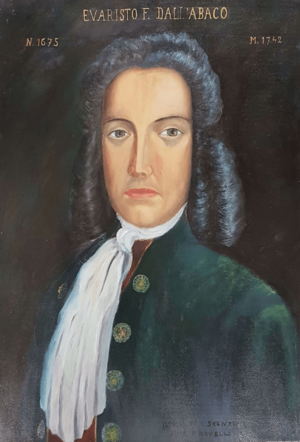Evaristo Felice Dall'Abaco facts for kids
Evaristo Felice Dall'Abaco (born July 12, 1675, in Verona, Italy – died July 12, 1742, in Munich, Bavaria) was a famous Italian composer. He was also a talented musician who played the violin and cello. He lived during the Baroque period of music.
Contents
Who Was Evaristo Dall'Abaco?
Evaristo Dall'Abaco was born in Verona, Italy. His father, Damiano dall'Abaco, was a well-known guitarist. Young Evaristo likely learned to play the violin and cello from Giuseppe Torelli, another important musician.
Starting His Music Career
Dall'Abaco began his career as a violinist in Modena. He played alongside Tommaso Antonio Vitali. In 1704, he joined the court of Maximilian II Emanuel, Elector of Bavaria in Munich. Here, he became a Kammermusiker, which means a court musician.
Life in Exile
After only a few months, Dall'Abaco had to leave Munich. This happened because Maximilian's army lost the Battle of Blenheim. Dall'Abaco went into exile with the court, first to Brussels. During this time, he also spent time in France. He learned new musical styles and ideas from the French musicians.
Return to Munich
In 1715, Maximilian returned to Munich. Dall'Abaco also came back and was given an even more important job. He became the Concert-meister, which means the leader of the court orchestra. He continued to write chamber music for the courts in France and the Netherlands. He retired in 1740.
Dall'Abaco's music was greatly influenced by other famous composers. These included Antonio Vivaldi and Arcangelo Corelli. Evaristo Dall'Abaco passed away on his 67th birthday.
While he was in Brussels, Dall'Abaco had a son named Joseph Abaco (1710–1805). Joseph also became a well-known musician.
What Music Did He Write?
Dall'Abaco published several collections of his music. These collections are often called "Opus" followed by a number. An "Opus" is a way to number a composer's works.
- Opus 1: 12 Sonate da Camera (Chamber Sonatas). These were written for violin and violoncello with other instruments.
- Opus 2: 12 Concerti a quattro da Chiesa (Concertos for four instruments, for church).
- Opus 3: 12 Sonate da Chiesa a tre (Church Sonatas for three instruments).
- Opus 4: 12 Sonate da Camera a violino e violoncello (Chamber Sonatas for violin and violoncello).
- Opus 5 & 6: Concerti a piu Instrumenti (Concertos for many instruments).
See also
 In Spanish: Evaristo Felice dall' Abaco para niños
In Spanish: Evaristo Felice dall' Abaco para niños


